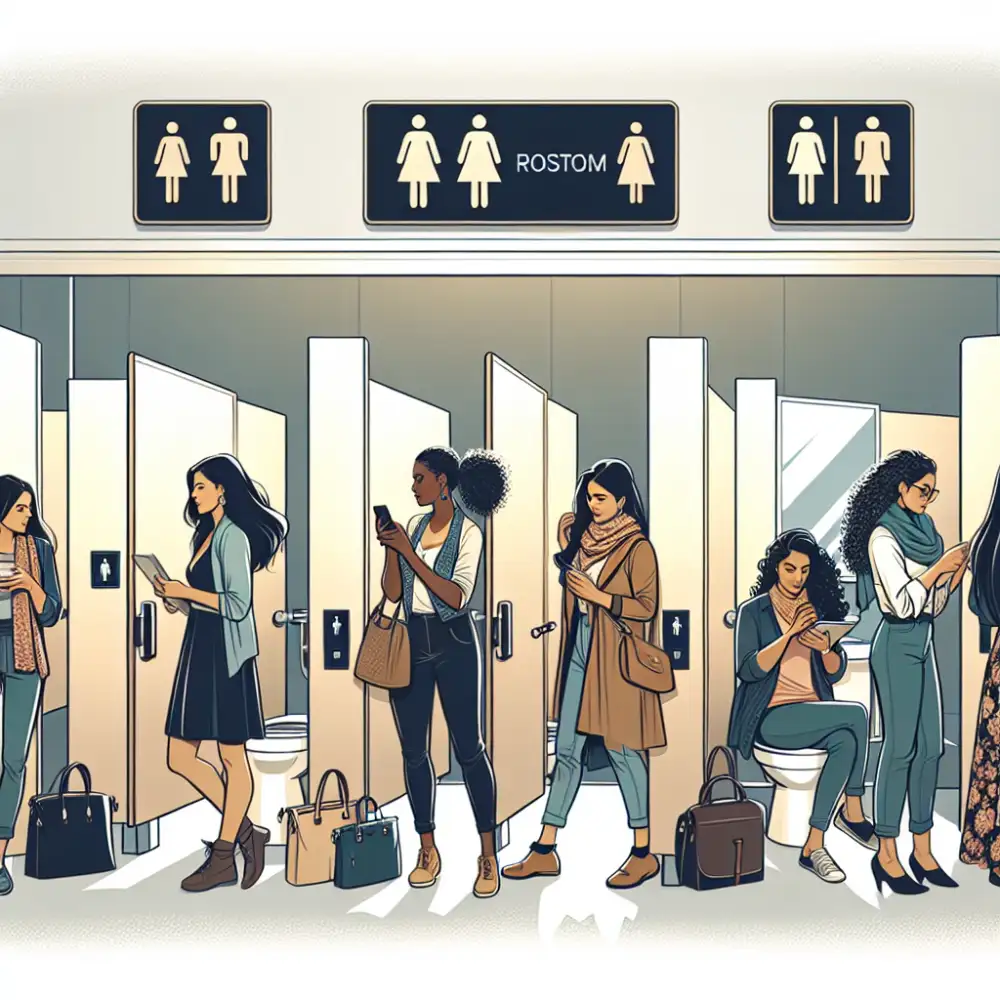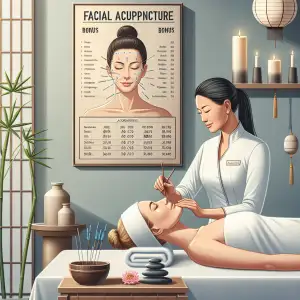Bathroom Break Bliss: Why Women Need More

The eternal wait for the ladies' room
It's a tale as old as time. You're at a concert, a sporting event, or even just out for a nice dinner, and nature calls. You cheerfully join the queue for the ladies' room, only to be met with a line snaking out the door. Meanwhile, your male companion breezes in and out of the men's room in a flash. Sound familiar? The disparity in wait times between men's and women's restrooms is a common source of frustration for women everywhere. There are several contributing factors, and they go beyond simple biology.
While it's true that women, on average, may spend a bit longer in the stall itself, the real culprit often lies in the design. Women's restrooms are frequently allotted the same square footage as men's, despite the need to accommodate more fixtures and users. This means fewer toilets per person and longer lines. Add to that the lack of adequate space for diaper changing and the pressure of societal expectations for women to spend more time on their appearance, and it's no wonder the wait feels eternal.
The good news is that awareness of this issue is growing. Architects and designers are beginning to incorporate more equitable restroom designs in public spaces, prioritizing functionality and efficiency. Some venues are even adopting gender-neutral restrooms, which can help alleviate wait times for everyone. Until then, ladies, we'll keep our fingers crossed for shorter lines and maybe pack a good book in our purses, just in case.
Bladder capacity and frequency myths
Many women worry about how often they go to the bathroom. It's easy to feel like you're going too much or not enough. Let's clear up some common myths about bladder capacity and frequency. There's no magic number for how many times a day you should pee. Most adults go around 6-8 times in 24 hours, but anywhere between 4 and 10 can be totally normal. Your bladder is like a muscle. It stretches and shrinks. Holding it for too long or going "just in case" too often can make your bladder "lazy." What you drink matters a lot. Coffee, tea, alcohol, and sugary drinks can make you go more. Stress can play a huge role. Ever notice how you need to go more when you're nervous? That's totally normal. Kegels aren't just for after childbirth. These exercises strengthen your pelvic floor muscles, which help control your bladder. If you're constantly worried about your bathroom habits, talk to your doctor. They can rule out any underlying medical conditions and offer advice. Remember, everyone's body is different. What's normal for your friend might not be normal for you, and that's okay.
Peeing: What's normal, what's not
We all know the feeling: when you gotta go, you gotta go! But have you ever stopped to think about what’s considered normal when it comes to peeing? Let’s dive into the wonderful world of women’s urination.

How Often Should You Pee?
Most women pee around six to eight times a day. However, this can vary depending on factors like how much you drink, your bladder size, and certain medications.
What’s a Normal Pee Stream Like?
Ideally, your pee stream should be strong and steady. If it’s weak, hesitant, or feels like it’s coming out in dribbles, it might be worth chatting with your doctor.
The Color Palette of Pee
We’re not talking about a fashion statement here! The color of your urine can actually tell you a lot about your hydration levels. A pale yellow color is ideal. If it’s dark yellow, you’re probably a little dehydrated and need to drink more water. On the other hand, completely clear pee could mean you’re drinking a bit too much water.
Those Burning Questions
Ever experience a painful, burning sensation while peeing? That’s definitely not normal and could be a sign of a urinary tract infection (UTI). UTIs are more common in women due to our anatomy.
When to See a Doctor
While some variation in your bathroom habits is normal, there are a few red flags that warrant a trip to the doctor:
Pain or burning during urination
Frequent urination, especially at night
Difficulty starting or stopping your pee stream
Blood in your urine
Leaking urine
Remember, ladies, paying attention to your bathroom habits can give you valuable insights into your overall health. Don’t hesitate to reach out to your healthcare provider if you have any concerns – they’ve heard it all before!
Public restrooms: friend or foe?
Public restrooms. Those two words can elicit a range of emotions in women, from mild anxiety to full-blown dread. Let's be real, ladies, we've all been there. The mad dash to find one that's clean, safe, and (hopefully) not out of toilet paper.
For many women, public restrooms aren't just about a quick pit stop. They can be a source of stress, discomfort, and even fear. Long lines, questionable cleanliness, and a lack of privacy are just a few of the issues we often face. And let's not forget the dreaded "hover technique" many of us have perfected over the years to avoid contact with those less-than-sanitary surfaces.
Then there's the issue of safety. Sadly, public restrooms, especially those in isolated locations, can be vulnerable to harassment and assault. It's a sad reality that many women feel the need to take extra precautions, like checking stalls for hidden cameras or asking a friend to wait outside.
But it's not all doom and gloom. There are movements pushing for better public restroom facilities for women. Advocates are calling for cleaner restrooms, increased safety measures, and more stalls to address the disparity in wait times between genders. Some places are even implementing gender-neutral restrooms to provide a more inclusive and accessible option for everyone.

So, are public restrooms friend or foe? It's complicated. They're a necessity we can't avoid, but they often fall short of our needs and expectations. As we continue to advocate for better and safer facilities, let's hope that one day, a trip to the public restroom won't be such a gamble.
Period woes in public restrooms
Public restrooms can be a minefield of awkwardness on a good day, but add period cramps and the sudden need for supplies, and it's a whole new level of stress. We've all been there – the frantic purse rummage, the silent plea for a spare tampon from a stranger, the awkward walk of shame to the dispenser (that's often empty anyway).
Let's talk about the elephant in the stall – or rather, the lack of supplies. It's 2023, and we're still battling the taboo around menstruation. Why are period products not treated as essential as toilet paper or soap? Providing free and accessible menstrual products in public restrooms shouldn't be a radical concept. It's about basic hygiene and dignity.
And while we're at it, can we talk about the design flaws? Tiny stalls that barely fit a human, let alone a purse and a winter coat. The lack of shelves to place your belongings, forcing you to play a precarious balancing act with your bag and your dignity. And the trash cans – oh, the tiny trash cans that overflow with the remnants of everyone's day.
We need to normalize periods and create restroom environments that reflect that. This means advocating for free period products, demanding better designs that prioritize women's needs, and fostering open conversations that dismantle the stigma surrounding menstruation. It's time to ditch the shame and make public restrooms a little less stressful, one period at a time.
Traveling? Plan your bathroom breaks!
For us ladies, finding a decent public restroom on the go can sometimes feel like searching for a mythical creature. But don't worry, your bladder and your peace of mind are safe with us! We've got the ultimate guide to help you plan those bathroom breaks like a pro.
First things first, preparation is key. Before you even leave the house, make sure you're well-hydrated. It sounds counterintuitive, but holding it in can actually make things worse, leading to discomfort and potential health issues. Now, let's talk strategy. When you're out and about, be on the lookout for those bathroom oases. Department stores, chain restaurants, and shopping malls are generally good bets. They usually have larger restrooms and higher standards of cleanliness.
Ever heard of mapping apps? They aren't just for directions anymore! Many of them can point you to the nearest public restrooms, saving you from frantic searches. And hey, don't be shy about asking for directions. Locals or shopkeepers can often guide you to a nearby restroom. Now, let's talk about those times when nature calls, but a decent restroom seems miles away. This is where a little travel hack comes in handy - the "I need to use the restroom" card.


Simply write this phrase down on a piece of paper or your phone's notepad. In situations where language barriers exist or you're feeling too shy to ask, this card can be a lifesaver. Just show it to someone who works at a restaurant or shop, and they'll likely understand. Remember ladies, staying comfortable on the go is all about planning and a little resourcefulness. With these tips, you can conquer any adventure without bathroom worries holding you back!
Importance of pelvic floor health
Pelvic floor health is super important for women of all ages, especially when it comes to going to the bathroom. Think of your pelvic floor muscles like a hammock that supports your bladder, uterus, and rectum. These muscles help you control when you pee and poop, which is essential for avoiding embarrassing accidents.
When your pelvic floor muscles are weak or too tight, it can lead to issues like urinary incontinence (leaking urine), fecal incontinence (leaking stool), and even pelvic organ prolapse (when organs start to drop down). Not fun, right?
So, how can you keep your pelvic floor happy and healthy? One word: Kegels! Kegel exercises are like mini-workouts for your pelvic floor. They involve squeezing and relaxing the muscles that control your pee flow. It's like you're trying to stop yourself mid-stream (but not while you're actually on the toilet!).
Doing Kegels regularly can strengthen your pelvic floor, improve bladder control, and even enhance intimacy. You can do them anywhere, anytime – while you're waiting in line at the grocery store, sitting at your desk, or even watching TV.
But Kegels aren't the only thing that matters. Your bathroom habits play a role too. When you gotta go, don't hold it in for too long. And when you do go, make sure you're relaxed and not straining. Straining can put extra pressure on your pelvic floor, which is a big no-no.
Another bathroom tip: Ditch the "just in case" peeing! You know, when you go to the bathroom "just in case" even if you don't really have to go. This can actually train your bladder to feel full when it's not, leading to more frequent bathroom trips.

Taking care of your pelvic floor health is crucial for your overall well-being. It's about feeling confident, comfortable, and in control of your body. So, start doing those Kegels, be mindful of your bathroom habits, and don't hesitate to talk to your doctor if you have any concerns. Remember, a healthy pelvic floor equals a happier you!
Quick tips for bathroom emergencies
Let's face it, bathroom emergencies can happen anytime, anywhere. And when you gotta go, you gotta go! But don't worry, we've got your back (or should we say, bladder?) with these quick tips to navigate those unexpected situations like a pro.
First things first, always be prepared. Keep a small emergency kit in your purse or car. Include essentials like travel-sized tissues, wet wipes, and hand sanitizer. Trust us, you'll thank yourself later.
Public restrooms can be a hit or miss. If you find yourself facing a less-than-ideal situation, don't panic. Use toilet seat covers or layer toilet paper as a barrier. And remember, the hover technique is a last resort, but it works in a pinch.
Period woes got you down? Don't let an unexpected visit from Aunt Flo catch you off guard. Keep a spare tampon or pad in your bag at all times. If you're caught without one, ask a fellow lady in the restroom. Chances are, they've been there too and will be happy to help.
Urinary tract infections (UTIs) are no joke. If you experience burning or pain during urination, don't ignore it. Drink plenty of water and cranberry juice (unsweetened, of course) to help flush out bacteria. And if symptoms persist, see a doctor ASAP.
Speaking of UTIs, always remember to wipe from front to back after using the restroom. This simple habit can help prevent bacteria from spreading and causing infections.
And last but not least, always listen to your body. If you feel the urge to go, don't hold it in. Holding it for too long can weaken your bladder muscles over time. So go ahead, find a restroom, and let it flow!
Published: 23. 06. 2024
Category: Food



